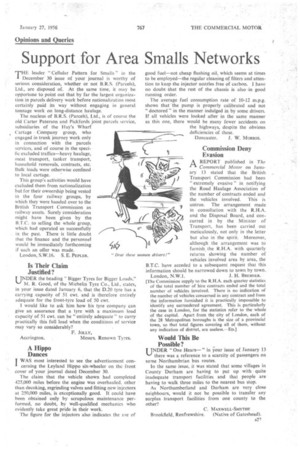Opinions and Queries
Page 29

If you've noticed an error in this article please click here to report it so we can fix it.
Support for Area Smalls Networks
'THE leader "Cellular Pattern for Smalls" in the I December 30 issue of your journal is worthy of serious consideration, whether or not B.R.S. (Parcels), Ltd., are disposed of. At the same time, it may be opportune to point out that by far the largest organization in parcels delivery work before nationalization most certainly paid its way without engaging in general tonnage work on long-distance haulage.
The nucleus of B.R.S. (Parcels), Ltd., is of course the old Carter Paterson and Pickfords joint parcels service, subsidiaries of the Hay's Wharf Cartage Company group, who engaged in trunk journey work only in connection with the parcels services, and of course in the specifie excluded traffics—heavy haulage, meat transport, tanker transport, household removals, contracts, etc. Bulk loads were otherwise confined to local cartage.
This group's activities would have excluded them from nationalization but for their ownership being vested in the fpur railway groups, by which they were handed over to the British Transport Commission as railway assets. Surely consideration might have been given by the B.T.C. to selling the whole group, which had operated so successfully in the past. There is little doubt that the finance and the personnel would be immediately forthcoming if such an offer was made.
London, S.W.16. S. E. PEPLER.
Is Their Claim Justified?
UNDER the heading "Bigger Tyres for Bigger Loads," M. R. Good, of the Michelin Tyre Co., Ltd., states, in your issue dated January 6, that the D.20 tyre has a carrying capacity of 51 cwt. and is therefore entirely adequate for the front-tyre load of 50 cwt.
I would like to ask him how his tyre company can give art assurance that a tyre with a maximum load capacity' of 51 cwt. can be "entirely adequate" to carry practically this full load when the conditions of service may vary so considerably?
F. JOLLY, Accrington. Messrs. Renown Tyres.
A Hippo Dances
I WAS most interested to see the advertisement con1 cerning the Leyland Hippo six-wheeler on the front cover of your journal dated December 30.
The claim that the vehicle shown had completed 425,000 miles before the engine was overhauled, other than decoking, regrinding valves and fitting new injectors at 250,000 miles, is exceptionally good. It could have been obtained only by scrupulous maintenance performed, no doubt, by well-qualified mechanics who evidently take great pride in their work.
The figure for the injectors also indicates the use of
good fuel—not cheap flushing oil, which seems at times to be employed—the regular cleaning of filters and attention to keep the injector nozzles free of carbon. I have no doubt that the rest of the chassis is also in good running order.
The average fuel consumption rate of 10-12 m.p.g. shows that the pump is properly calibrated and not " doctored " in the manner indulged in by some drivers. If all vehicles were looked after in the same manner as this one, there would be many fewer accidents on the highways, despite the obvious deficiencies of these.
Doncaster. J. W. MORRIS.
Commission Deny Evasion
A REPORT published in The
Commercial Motor on January 13 stated that the British Transport Commission had been "extremely evasive" in notifying the Road Haulage Association of the number of contracts ended and the vehicles involved. This is untrue. The arrangement made in consultation with the R.H.A. and the Disposal Board, and concurred in by the Minister of Transport, has been carried out meticulously, not only in the letter but also in the spirit. Moreover, although the arrangement was to furnish, the R.H.A. with quarterly returns showing the number of vehicles involved area by area, the _B.T.C, have acceded to a subsequent request that this information should be narrowed down to town by town..
London, N.W.1. J. H. BREBNER.
[The Commission supply to the R.H.A. each quarter statistics of the total number of hire contracts ended and the total number of vehicles involved. There is no indication of the number of vehicles concerned in any contract and from the information furnished it is practically impossible to identify any surrendered agreement. This is particularly the case in London, for the statistics refer to the whole of the capital. Apart from the city of London, each of the N Metropolitan boroughs is the size of a provincial town, •so that total figures covering all of them, without any indication of district, are useless.—ED.]
Would This Be Possible?
UNDER "One Hears—" in your issue of January 13 there was a reference to a scarcity of passengers on some Northumbrian bus routes.
In the same issue, it was stated that some villages in County Durham are having to put up with quite inadequate transport facilities and that people are having to walk three miles to the nearest bus stop.
As Northumberland and Durham are very close neighbours, would it not be possible to transfer any surplus transport facilities from one county to the other?
C. MAXWELL-SMYTHE Brookfield, Renfrewshire. (Native of Gateshead).




































































